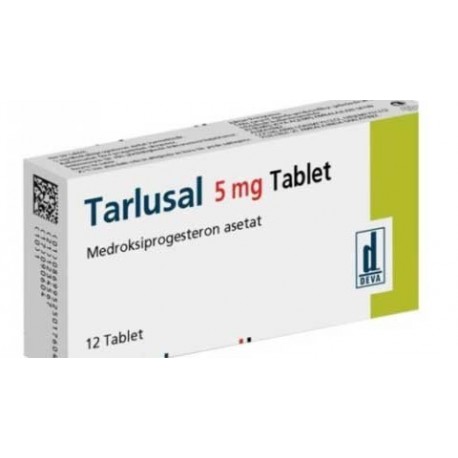 View larger
View larger Provera (Medroxyprogesterone) 5 Mg 12 Tablets
TRL0227
New product
BUY MORE PAY LESS
| Quantity | Discount | |
|---|---|---|
| 2 | 5% | |
| 3 | 10% | |
| 4 | 15% | |
| 5 | 20% |
Volume discounts
| Quantity | Discount | You Save |
|---|---|---|
| 2 | 5% | Up to $3.20 |
| 3 | 10% | Up to $9.60 |
| 4 | 15% | Up to $19.20 |
| 5 | 20% | Up to $32.00 |
More info
TARLUSAL (Provera) 5 mg tablet It is taken orally.
Active ingredient
Each tablet contains 5 mg of medroxyprogesterone acetate.
Excipients
Lactose monohydrate, talc, corn starch, sucrose, calcium
stearate, mineral oil (liquid paraffin)
1. What is TARLUSAL (Provera) and what is it used for?
• TARLUSAL (Provera) contains 5 mg medroxyprogesterone acetate in each tablet as an active ingredient.
• TARLUSAL (Provera) is a white, odorless, round tablet with the letter “T” on one side, smooth on both sides. It is available in blisters containing 12 tablets.
• The active ingredient of TARLUSAL, medroxyprogesterone acetate, belongs to a group of drugs called progestogens. Progestogens are similar to the natural female hormone progesterone.
• TARLUSAL (Provera) excessive secretion of estrogen (a group of hormones that play an important role in the menstrual cycle of women) and severe or irregular menstrual bleeding and other menstrual problems, amenorrhea and endometriosis (the presence of endometrial tissue in a place other than its normal place in the uterus) used in the treatment.
2. How to use TARLUSAL (Provera)?
Instructions for proper use and dose/frequency of administration
Please follow your doctor's instructions carefully. The number of tablets you take depends on the condition you are being treated for. The information below will allow you to see what dose is usually used for a particular condition.
In endometriosis:
10 mg (30 mg) three times a day for 3 months (90 days) starting on the first day of your period. If you experience irregular drip or normal bleeding during treatment, this is normal and there is no need to worry.
For heavy or irregular menstrual bleeding and other menstrual problems:
2.5 mg-10 mg for 8-10 days, usually 16 days after the start of your last menstrual period. You will usually have menstrual-like bleeding for a few days after you stop using the tablets.
In the treatment of amenorrhea:
Your treatment will be repeated for three periods, 2.5-10 mg per day for 5-10 days. You will usually have menstrual-like bleeding for a few days after you stop using the tablets. In some cases, your doctor may also prescribe 5-10 mg of estrogen hormone for 10 days simultaneously with TARLUSAL (Provera).
Application route and method
It is taken orally.
You can use TARLUSAL (Provera) before or after meals.
Swallow TARLUSAL tablets with a sufficient amount of water (eg, 1 glass of water) without chewing or crushing them.
different age groups
Use in children
It is not used in this age group.
Use in the elderly
It is not used in this age group.
Special use cases
Kidney failure:
No dosage adjustment is necessary in patients with renal impairment.
Liver failure:
Your doctor will tell you which dose and how many tablets you should take. Do not use TARLUSAL in severe liver failure.
3. What are the possible side effects?
Like all medicines, there may be side effects in people who are sensitive to the substances contained in TARLUSAL (Provera).
If any of the following occur, stop using TARLUSAL (Provera) and IMMEDIATELY inform your doctor or go to the nearest hospital emergency department:
- Hypersensitivity reactions (wheezing, shortness of breath, feeling faint, swelling of the face or tongue, hands and feet, skin rash with severe itching)
These are all very serious side effects.
If you have one of these, it means that you are allergic to TARLUSAL. You may need emergency medical attention or hospitalization.
Side effects in this leaflet are listed as shown in the following categories.
Very common Common
It can be seen in at least 1 of 10 patients.
It can be seen less than one in 10 patients, but more than one in 100 patients. Less than one in 100 patients, but more than one in 1,000 patients
It can be seen in less than one in 1,000 patients.
It can be seen in less than one in 10,000 patients.
It cannot be estimated from the available data.
It can be seen uncommon.
Rare Very rare Not known
Rare:
- Vascular occlusion,
-Deep-vein thrombosis (blood clotting in the vein) (severe pain and bruising in your leg) -Weight change, edema/fluid retention, swelling in the hands and wrists -Depression, insomnia, nervousness, headache, drowsiness, dizziness,
-Nausea
-Acne, hair loss, excessive facial or body hair growth, itching, rash, hives
- Milky discharge from the breast (galactorrhea), pain in the breast and
sensibility
-Fatigue, fever
- Decreased glucose tolerance,
Unknown:
-Prolonged absence of egg formation in the female ovary
- Abnormal uterine bleeding (irregular, increasing, decreasing), absence of menstruation, uterus
mouth abrasions and vaginal discharge,
-Blood clot in the brain (abnormal, prolonged headache, impaired vision, difficulty speaking, or fainting)
-Blood clot in the lung (sudden, severe pain in your chest, coughing up blood)
-Jaundice

